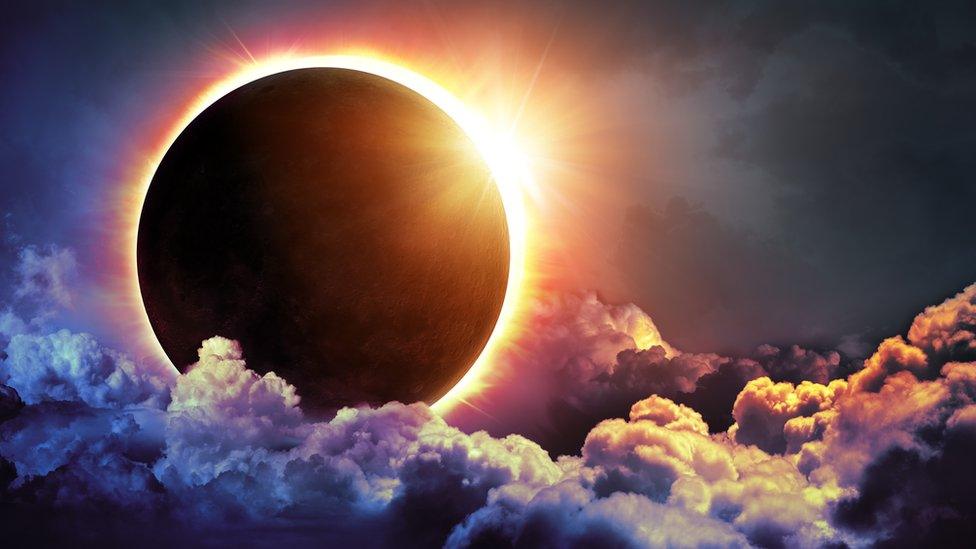South American solar eclipse: Everything you need to know
- Published
- comments

There's going to be a total solar eclipse on Tuesday as the Moon passes between the Earth and the Sun.
This will be the first total solar eclipse since August 2017, when millions of people in the United States were able to see the natural phenomenon for themselves.
However, this time the eclipse will not be seen in the US, UK or anywhere else in the northern half of the world.
The best place to see the eclipse will be in South American countries including Chile or Argentina.
Read on to find out everything you need to know about this amazing event.
What is a solar eclipse?
WATCH: Relive the incredible total solar eclipse from 2017 with 91热爆 reporter Nada Tawfik
A solar eclipse is when the Moon moves between the Sun and the Earth, so it blocks the Sun's light. This casts a shadow over part of the Earth.
The area on the Earth where the shadow directly falls, is the point at which people will be able to see a total solar eclipse.
This is because the Moon will be completely blocking the sun's light here, so it will fall dark for a short time just like it's night time - even if it is the middle of the day!
Total solar eclipses can be confusing for animals, because they think that it is night time
When the Moon is directly in front of the Sun and covers it completely, people will see details of the Sun's atmosphere, which you can't usually see, glowing around the edge of the Moon.
This is one of the reasons that a total solar eclipse is such a spectacular sight.
As the Moon moves, the shadow it casts moves across the Earth.
A total solar eclipse is one of the most spectacular space sites that can be seen from the Earth
The route that this shadow takes is called the path of totality. Anyone watching the eclipse from an area that is on this path of totality will be able to see a total solar eclipse.
Outside of this area, you can still see the Moon blocking the Sun and casting a shadow, but it will only be blocking part of the Sun. So anyone in these areas will only be able to see a partial social eclipse.
This will look a bit like the Moon is 'taking a small bite' out of the sun!
When is the 2019 South American Total Solar Eclipse?
This map shows the path and location where people will be able to see the total solar eclipse
This rare event will take place on Tuesday 2 July shortly after 4.30pm in South America and just after 8.30pm UK time.
The Moon will first start to cover the Sun above the Pacific Ocean at 12.55pm.
When the Moon fully covers the Sun, it's called totality and that will be seen first over Oeno Island, which is a British territory in the South Pacific Ocean.
The first place in South America to see totality will be near La Serena in Chile.
How long will it last?
This picture shows how a shadow is cast on the Earth when the Moon moves in between the Sun and the Earth
It depends on the eclipse, but generally during a total eclipse, the Moon will only block the Sun's light for a couple of minutes.
The upcoming eclipse might be particularly spectacular for people in South America, as it's happening right before sunset. The peak of the eclipse, the totality, will last for around 2 minutes.
When will we see a solar eclipse in the UK?
This is what the Sun looks like during a partial solar eclipse - a bit like the Moon is 'taking a bite' out of the Sun
As the UK isn't on the path of the eclipse, in short, we will see nothing this time. It will be a regular afternoon here in Britain.
The next really good eclipse that we will be able to see in the UK will be on 12 August 2026, when there will be a very large partial eclipse across Britain, where 96% of the sun will be covered by the moon if you're watching from Cornwall and 91% if you're far north in say Aberdeen.
The next total eclipse visible in the UK is not until 23 September 2090.
How can you watch a solar eclipse safely?
It is extremely important that you don't look at the eclipse directly unless you have proper protective glasses
If you want to watch a solar eclipse you may have to travel abroad, unless you wait until 2026 here in the UK. However, wherever you go to watch an eclipse you must do it safely:
Never look directly at the Sun: you can damage your eyes forever
Even the amount of Sun peeking out from behind the Moon during an eclipse is enough to make you go blind, so you must never look at it directly
Never look at the Sun through binoculars or a telescope.
Don't look directly at the Sun through sunglasses, a camera or your phone camera - none of these suitably protect your eyes
In order to watch an eclipse happening, you will need special glasses. These are specially darkened and filtered to protect your eyes.
WATCH: How to make a pinhole camera
Alternatively, you can use a special pinhole camera, which you can make easily at home.
Make sure that you are standing as far away from any artificial light - like bright houses or street lamps - as possible, as the darker it is where you are, the better your view will be.
